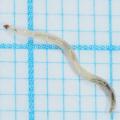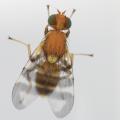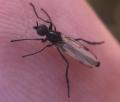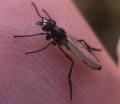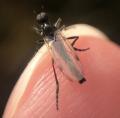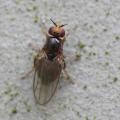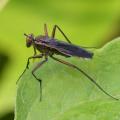Diptera.info :: Identification queries :: Diptera (adults)
Who is here? 1 guest(s)
|
Which Gymnosoma species?
|
|
| gardensafarinl |
Posted on 05-02-2006 08:19
|
|
Member Location: Arnhem, the Netherlands Posts: 79 Joined: 09.01.06 |
Dear Members, I have this fly on my site, named Gymnosoma nudifrons. Now it has been suggested this it is a Gymnosoma rotundatum instead. Is anyone able to tell me which species it is is from just these pictures? Thanks a lot in advance.    Cheers, Hans |
| Zeegers |
Posted on 05-02-2006 14:01
|
|
Member Location: Soest, NL Posts: 18535 Joined: 21.07.04 |
I cannot be sure. I understand the critics on nudifrons, but still my guess is it is nudifrons. I think the black on the parafrontalia just seem not to reach the antennal base but that they actually do. An artifact of the point of view of the camera. To be sure, I need a headshot from front or above. The dark wings suggest nudifrons Another way to determine the identity might be this: If the picture is taken in The Netherlands outside Limburg, it must be G. nudifrons. Since G. rotundatum is restricted to Limburg. G. nudifrons is actually quite common. Maybe that helps ? Theo |
|
|
|
| gardensafarinl |
Posted on 05-02-2006 15:09
|
|
Member Location: Arnhem, the Netherlands Posts: 79 Joined: 09.01.06 |
Thanks a lot Theo, I was uncertain because I received some criticism on my site. I have worked for waarneming.nl for a while and there was G, rotundatum, but no G. nudifrons. Actually I parked the problem and didn't report this to waarneming.nl. But now I have and I used the name G. nudifrons. I am curious whether Mark van Veen reacts to all this... |
| Zeegers |
Posted on 05-02-2006 16:01
|
|
Member Location: Soest, NL Posts: 18535 Joined: 21.07.04 |
Gardensafari, I think your site is great! The people who criticize Gymnosoma nudifrons, might simple not be familiar with the species. It has been described as recently as 1966. Most old records of 'rotundatum' refer actually to nudifrons. I had a good look at your site, and I'm now confident that this is indeed, a female nudifrons. So don't worry about the critics, just send them my critics. Theo |
|
|
|
| Andre |
Posted on 05-02-2006 16:08
|
|
Member Location: Tilburg, the Netherlands Posts: 2111 Joined: 18.07.04 |
Waarneming.nl is not that good site for dipterists... my opinion.. |
| gardensafarinl |
Posted on 05-02-2006 17:08
|
|
Member Location: Arnhem, the Netherlands Posts: 79 Joined: 09.01.06 |
Zeegers wrote: Gardensafari, I think your site is great! The people who criticize Gymnosoma nudifrons, might simple not be familiar with the species. It has been described as recently as 1966. Most old records of 'rotundatum' refer actually to nudifrons. I had a good look at your site, and I'm now confident that this is indeed, a female nudifrons. So don't worry about the critics, just send them my critics. Theo Thanks a lot, Theo. I do my best and I am still happy I stick to what lives in my garden, otherwise I would certainly run out of time. Flies and wasps are still the most difficult groups. I know, there are some micro moth families which are terrible too. And of course aphids and such aren't very easy either. Problem seems to be there are only a limited number of people interested in these groups (except for syrphids, which for some reason or another are extremely popular). But I am glad that many of my question do get an answer here. Some pictures apparently don't mean a thing to anyone, so that's a good reason to put them back where they came from: the archives. Well it is still winter, so maybe another fly will pop up from the archives. This is the time of year to work on the site and the pictures etc. Let's hope there will be a lot of life again in about one month... It is rather 'dead' outside nowadays. Except for a few very small mosquitoes of course. I'll save them for later, for many are so small my camera won't like them.... Cheers, Hans |
| gardensafarinl |
Posted on 05-02-2006 17:25
|
|
Member Location: Arnhem, the Netherlands Posts: 79 Joined: 09.01.06 |
Andre wrote: Waarneming.nl is not that good site for dipterists... my opinion.. I did some work for them, so just a very few short remarks. Their goal is to collect observations and actually that's all. They started off as a birding group, which one can still tell. But to check out the observations reported, they need experts. But the observations are numerous, the observers are very diverse what their knowledge is concerned, making corresponding with them not always as easy as can be. On the other hand all these observations are valuable and it is up to each and every scientist to interpret them. But, yes they still lack some expertise. Mark van Veen is an excellent dipterist, but he's no specialist on all families. And except for syrphids he's on his own. The same goes for some other groups of animals (bees, wasps, aphids, spiders). Concerning some other groups though I think they are quite reliable: birds, butterflies, plants and moths for instance. And by the way I find the information on flies on the internet to be mediocre at best most of the times (except for this site, of course  Cheers, Hans |
| Jump to Forum: |



